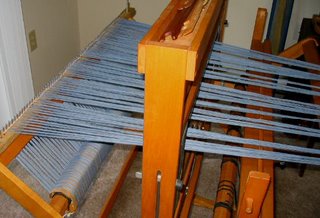 By
Leigh
By
LeighFiber folks are normally a congenial lot: friendly, helpful, generous, easy going. But there are a few controversies which sometimes seem to have a definite Jekyll and Hyde effect on us.
One of them is the Scotch tension vs. double drive debate. I resigned my participation from this one a long time ago, having set up my Ashford Traddy with Scotch tension and my Kromski Minstrel in double drive.
The other debate seems to be over which is the best way to warp one’s loom: front to back, or back to front. So far I’ve merely been a bystander. I learned f2b and except for one dismal attempt to learn b2f four years ago, have remained a f2b warper.
Until now. I’m not sure whether it was the lure of “more even tension,” or the appeal to my professional studentism. Or perhaps it was the twinges of guilt I felt when my husband would ask “Whatever happened to the thing I made for your loom,” referring to my raddle. So when fellow Online Guild member and former f2b warper Diana suggested it as another possible self study, it sounded good to me. And with 5 plus yards to put on the loom, now seemed like the perfect time to give this method another try.
So I’ve done my homework. In addition to Deb Chandler’s Learning to Weave, I’ve dug out Peggy Osterkamp’s Warping Your Loom & Tying on New Warps, checked out the OLG’s online resources, downloaded a how-to pdf file from Interweave Press, and took a close look at the contraption on Charleen’s Fiberblog.
I ended up choosing the Chandler method, mostly because it seemed most similar to what I’m already used to. I also have Osterkamp handy and am referring to it frequently. Here is my progress so far:
One of the things I’m realizing is that though I had previously thought I was doing a good job tensioning my warp, I really wasn’t. Some warps wove off beautifully, and some didn’t. But I couldn’t put my finger on what the problem was. (This is one of the unfortunate consequences of being largely self-taught.) In going back over the material now, I’m understanding things that I didn’t grasp before. I’m not sure if it’s like that for everyone, but I find that my brain can only process so much information before I have to put it to use. After that I can go back over the same information and pick up more details, which in turn I put into practice, and so on. Each time I go back over the material, I experientially understand more and more of it. Head knowledge is good, but experience transforms it into reality!
So I’m paying more attention to details I hadn’t noticed before, while still giving myself room to make mistakes and continue to learn. Hopefully this will be a lesson well learned, but the proof will be in the weaving of course. Next........b2f Part 2
Next........b2f Part 2Related Posts:
b2f Log Cabin Weaving - finished fabric from this series

4 comments:
I use both f2b and b2f depending on the type of warp I am putting on. I find that there is much less loom waste with b2f, so if my yarns are very dear, I use that method. If I am combining warps, I use f2b and combine then in the reed. I learned f2b first and for years thought that that was the only way to warp. Innocent little me. For most warps, I still prefer b2f, but I am glad that I know the alternate way to.
I know what you mean about brain overload too. I had a very competent teacher at the craft college that I went to. I know that she explained everything to us, but there were times when, even though I was in class, I must have missed it completly. I made so many mistakes in my first years. But eventually it all clicked. Thankfully I was in a class with about 8 or 9 other people and I was able to catch wat I had missed my watching them.
The only right answer to all those debats is "it depends". Different weaving and spinning situations require techniques to fit them. Usually when a person is adamantly in one camp, it's a reflection of their (narrow?) experience.
I think it's good that you're stretching your personal boundaries and identifying what works for you and when.
I'll follow along in your blog since there won't be much weaving here this summer as we tear down wallpaper, paint and carpet the first floor of the house. The looms will be under drop cloths.
I continue to go back and forth between the two warping methods. At this point, it seems that I prefer b2f for longer warrps and thinner cottons. For shorter, multicolored warps and for heavier woolen blankets f2b gives me more freedom to change threads around.
As for as spinning, I never could get the hang of double drive with my Schacht so used Scotch tension. My Lendrum Saxony seems to prefer double drive. Like Val said "it depends"!
No weaving comments...just wanted to say, "Hi, Rascal!"
Sweet kitty! (He misses me...I can see it in his eyes! LOL!)
Post a Comment